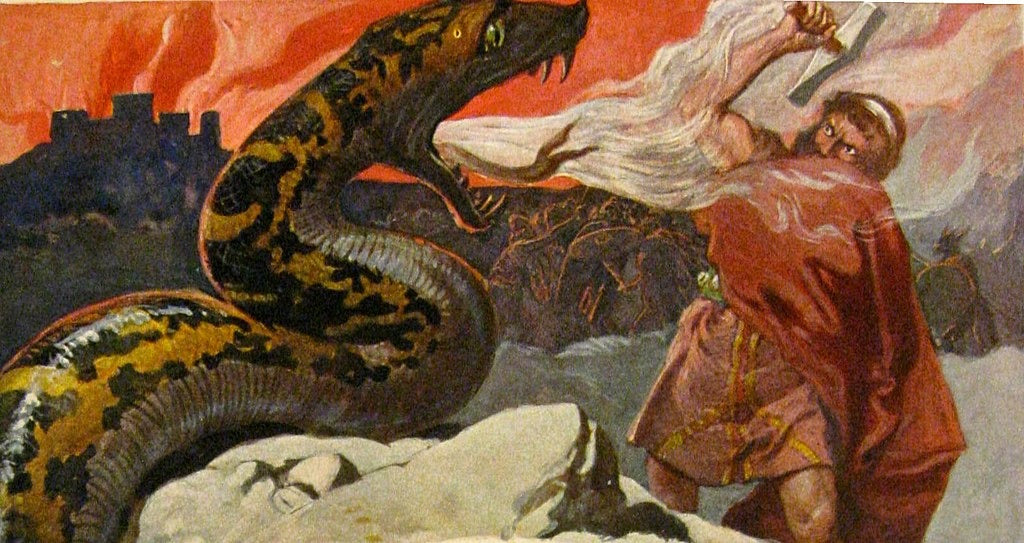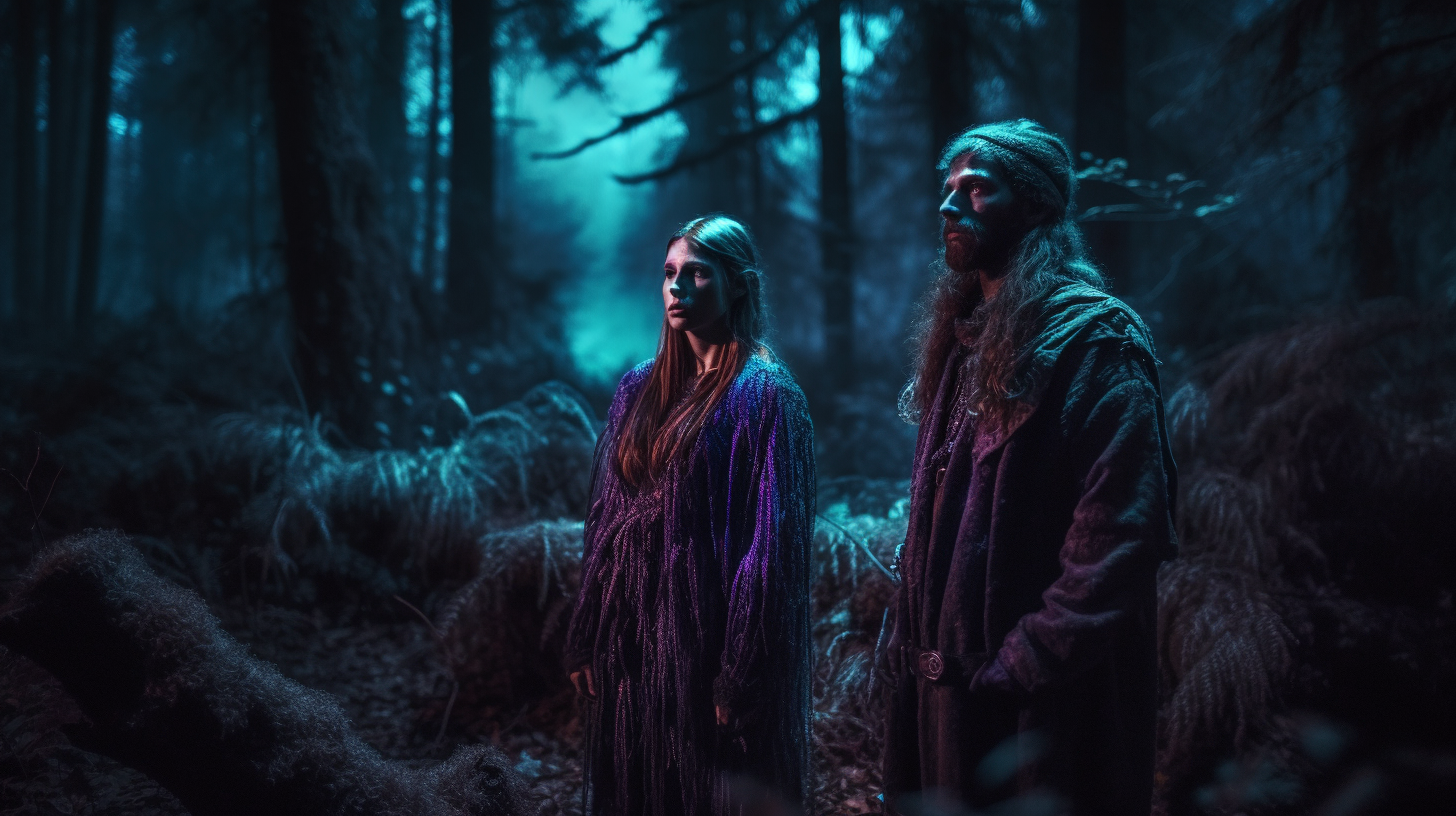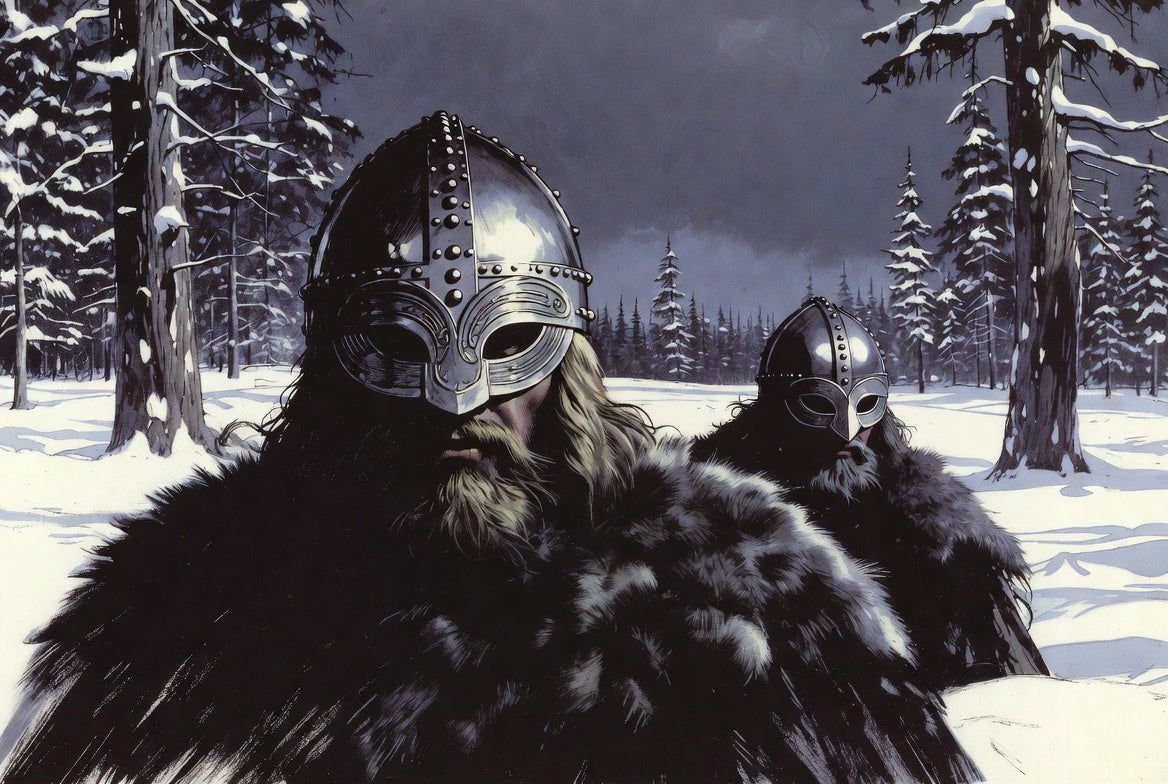
Jormungandr: The Colossal Serpent of Norse Mythology
In the vast tapestry of Norse mythology, few creatures loom as large or as menacing as Jormungandr, the World Serpent. This colossal entity, born of divine and monstrous parentage, plays a pivotal role in the cosmic drama of the Norse gods and their eventual downfall. But who exactly is Jormungandr, and why does this serpentine beast captivate our imagination even today?
Origins and Parentage

Loki's brood; Hel, Fenrir and Jörmungandr. The figure in the background is presumably Angrboða / Image credit: Martin Oldenbourg (Public Domain)
Loki's Monstrous Offspring
To understand Jormungandr, we must first look to its origins. The World Serpent is one of three monstrous children born to the trickster god Loki and the giantess Angrboða. Alongside its siblings, the wolf Fenrir and Hel, the goddess of the underworld, Jormungandr represents a force of chaos and destruction in the carefully ordered Norse cosmos.
The Poetic Edda, specifically in the Völuspá, briefly mentions this lineage:
"Loki begat the wolf
With Angrboða,
And Sleipnir bore he
To Svaðilfari;
One monster she thought
Worst of all,
Which sprang from the brother
Of Býleist's kin."
While not explicitly named here, the "monster" referred to is widely interpreted as Jormungandr.
The Prophecy of Ragnarök
From the moment of its birth, Jormungandr was destined to play a crucial role in the fate of the gods. The Norns, who weave the threads of destiny, foretold that this serpent would be instrumental in bringing about Ragnarök, the twilight of the gods. This prophecy would shape the actions of both the Æsir (the principal gods) and Jormungandr itself throughout Norse mythology.
Jormungandr in Norse Cosmology

Paganheim's 'Jormungandr bracelet'
The World Serpent's Role in the Norse Universe
In Norse cosmology, Jormungandr occupies a unique and terrifying position. After its birth, the Allfather Odin, fearing the prophecies surrounding Loki's children, took drastic action. He cast Jormungandr into the vast ocean that surrounds Midgard, the realm of humans.
Midgard's Encircler
But Jormungandr was not content to simply dwell in the depths. As it grew, the serpent stretched and expanded until it encircled the entire world, grasping its own tail in its mouth. This image of Jormungandr as the Midgard Serpent is one of the most enduring in Norse mythology, representing both the boundaries of the known world and the ever-present threat to cosmic order.
The Prose Edda, written by Snorri Sturluson, describes Jormungandr's position thus:
"The Midgard Serpent is so long that it encompasses all the land, and lies outstretched around it, and bites its own tail."
This description not only emphasizes Jormungandr's immense size but also links it to the concept of the ouroboros, a symbol of cyclicality and eternity found in many cultures.
Encounters with Thor

Thor and Hymir go fishing for the Midgard Serpent. From the 18th century Icelandic manuscript SÁM 66 in the care of the Árni Magnússon Institute in Iceland / Image credit: Jakob Sigurðsson (public domain)
The Fishing Expedition
One of the most famous tales involving Jormungandr is its encounter with Thor, the god of thunder. This story, recounted in both the Poetic and Prose Eddas, tells of a fishing trip taken by Thor and the giant Hymir.
Thor, ever the braggart, insisted on rowing far out to sea, much to Hymir's discomfort. Using the head of an ox as bait, Thor cast his line into the depths. What he hooked was none other than Jormungandr itself.
The Hymiskviða in the Poetic Edda vividly describes the moment:
"The warlike Thor
He tugged so hard
That both his feet
Went through the boat;
The mighty Thor
Against the serpent
Set his strength;
The hammer lifted."
This dramatic confrontation ended with Thor unable to land his catch, as Hymir, fearing for their lives, cut the line. Jormungandr slipped back into the depths, but not before Thor hurled his hammer Mjölnir at the retreating serpent.
Thor's Failed Attempt to Lift the Cat
Another tale involving Thor and Jormungandr, though indirectly, occurs during Thor's visit to the giant king Útgarða-Loki. Here, Thor is challenged to lift a large cat, which he finds surprisingly difficult. It's later revealed that this "cat" was actually Jormungandr in disguise, magically appearing much smaller than its true size.
This story, found in the Prose Edda, showcases not only Jormungandr's immense strength but also the clever illusions often employed in Norse myths.
Jormungandr's Appearance in Norse Literature

Jörmungandr (the Midgard Serpent) gets fished by an ox head from the 17th century Icelandic manuscript AM 738 4to / Public domain
Depictions in the Poetic Edda
The Poetic Edda, a collection of Old Norse poems, mentions Jormungandr in several key texts. In the Völuspá, the prophecy of Ragnarök includes a vivid description of Jormungandr's role:
"Jörmungandr writhes
in giant rage.
The serpent churns the waves."
This portrayal emphasizes the World Serpent's connection to the sea and its immense, world-shaking power.
Accounts in the Prose Edda
Snorri Sturluson's Prose Edda provides more detailed accounts of Jormungandr, including its origin, its placement in the ocean by Odin, and its encounters with Thor. The Prose Edda also elaborates on Jormungandr's role in Ragnarök, painting a vivid picture of the final battle between the serpent and Thor.
The Final Battle: Ragnarök

"Battle of the Doomed Gods" / Public domain
Jormungandr's Role in the Apocalypse
Ragnarök, the prophesied end of the world in Norse mythology, is where Jormungandr's true significance comes to the fore. As the world begins to end, Jormungandr is said to release its tail and emerge from the ocean, spewing venom that fills the sky and sea.
The Epic Clash with Thor
In this final battle, Jormungandr faces its old adversary, Thor. The Völuspá describes their confrontation:
"Thor advances,
Odin's son,
Viðarr, to fight
the fearsome beast.
He thrusts his sword
into the heart
of Hveðrungr's son,
avenging his father."
This epic clash results in Thor slaying Jormungandr, but at a terrible cost. The serpent's venom is so potent that even the mighty Thor can only take nine steps before succumbing to its effects, marking the end of both these powerful beings.
Symbolism and Interpretations

Paganheim's 'Midgard Serpent bracelet'
Jormungandr as a Representation of Chaos
In Norse mythology, Jormungandr often represents the forces of chaos and destruction that constantly threaten the ordered world of gods and humans. Its very existence as a child of Loki, coupled with its role in Ragnarök, underscores this symbolic function.
The Ouroboros Connection
The image of Jormungandr biting its own tail draws parallels with the ouroboros, an ancient symbol representing cyclicality and the eternal nature of existence. This connection adds depth to Jormungandr's symbolism, suggesting that even in its destructive role, it may be part of a larger cycle of cosmic renewal.
Legacy and Influence in Modern Culture
Jormungandr's influence extends far beyond ancient Norse texts. In modern popular culture, the World Serpent has inspired countless artistic depictions, literary references, and even appearances in video games and films. Its image as a colossal sea serpent has become a staple of fantasy literature and art, often representing primal forces of nature or cosmic threats.
From its portrayal in Marvel Comics' Thor series to its appearance in games like "God of War," Jormungandr continues to captivate our imagination, reminding us of the enduring power of Norse mythology in shaping our cultural landscape.
Conclusion
Jormungandr, the World Serpent of Norse mythology, stands as a testament to the rich and complex cosmology of the Norse people. From its origins as Loki's offspring to its pivotal role in Ragnarök, this colossal entity embodies the forces of chaos and destruction that constantly threaten the ordered world.
Yet, in its cyclical nature, biting its own tail, Jormungandr also represents the eternal cycle of creation and destruction, reminding us that even in the face of cosmic cataclysm, the potential for renewal always exists. As we continue to explore and reinterpret Norse mythology, Jormungandr remains a powerful symbol of the delicate balance between order and chaos that defines our understanding of the universe.
FAQs
- Why did Odin throw Jormungandr into the ocean?
Odin cast Jormungandr into the ocean out of fear, based on prophecies that Loki's children would bring about great destruction and play crucial roles in Ragnarök.
- Is Jormungandr always depicted as evil in Norse mythology?
While Jormungandr is generally portrayed as a destructive force, Norse mythology often presents a more nuanced view of good and evil. The World Serpent is more accurately seen as a natural force, part of the cosmic balance.
- How does Jormungandr compare to other mythological serpents?
Jormungandr shares similarities with other world-encircling serpents in various mythologies, such as the Greek Oceanus or the Aztec Quetzalcoatl. However, its specific role in Ragnarök and its battles with Thor make it unique.
- Are there any archaeological evidence of Jormungandr worship?
While there's no direct evidence of Jormungandr worship, serpent imagery is common in Norse archaeological finds. Some scholars interpret certain designs as potentially representing the World Serpent.
- How has the concept of Jormungandr influenced modern environmental thinking?
Some modern interpretations view Jormungandr as a metaphor for the delicate balance of nature. Its role in Ragnarök has been compared to modern concerns about environmental catastrophe, emphasizing the potential consequences of disrupting natural systems.
References
Byock, J. L. (Trans.). (2005). The Prose Edda. Penguin Classics.
Larrington, C. (Trans.). (2014). The Poetic Edda (Oxford World's Classics). Oxford University Press.
Lindow, J. (2002). Norse Mythology: A Guide to the Gods, Heroes, Rituals, and Beliefs. Oxford University Press.
O'Donoghue, H. (2008). From Asgard to Valhalla: The Remarkable History of the Norse Myths. I.B. Tauris.
Orchard, A. (1997). Dictionary of Norse Myth and Legend. Cassell.
Simek, R. (1993). Dictionary of Northern Mythology. D.S. Brewer.
Sturluson, S. (2005). The Prose Edda: Norse Mythology (J. L. Byock, Trans.). Penguin Classics.
Abram, C. (2011). Myths of the Pagan North: The Gods of the Norsemen. Continuum.
Davidson, H. R. E. (1964). Gods and Myths of Northern Europe. Penguin Books.
Gaiman, N. (2017). Norse Mythology. W. W. Norton & Company.
McCoy, D. (2016). The Viking Spirit: An Introduction to Norse Mythology and Religion. CreateSpace Independent Publishing Platform.
Page, R. I. (1990). Norse Myths. University of Texas Press.
Taggart, D. (2018). How Thor Lost His Thunder: The Changing Faces of an Old Norse God. Routledge.
Turville-Petre, E. O. G. (1964). Myth and Religion of the North: The Religion of Ancient Scandinavia. Holt, Rinehart and Winston.
Williamson, C. (2011). The Complete Old English Poems. University of Pennsylvania Press.








